

Map Reduce - A really simple introduction « Kaushik Sathupadi. Ever since google published its research paper on map reduce, you have been hearing about it.

Here and there. If you have uptil now considered map-reduce a mysterious buzzword, and ignored it, Know that its not. The basic concept is really very simple. and in this tutorial I try to explain it in the simplest way that I can. Note that I have intentionally missed out some deeper details to make it really friendly to a beginner. Chapter 1: Your CEO’s Strange itch: Imagine this. Dear <Your Name>, As you know we are building the blogging platform blogger2.com, I need some statistics. Picture yourself in that position for a moment. Occurance of one character words – Around 937688399933 Occurance of two chracter words – Around 23388383830753434 .. hence forth till 10 If homicide, suicide or resigining the job is not an option, how would you solve it?
MapReduce for App Engine. MapReduce Tutorial. This section provides a reasonable amount of detail on every user-facing aspect of the MapReduce framework.
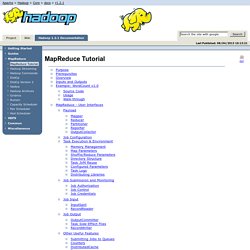
This should help users implement, configure and tune their jobs in a fine-grained manner. However, please note that the javadoc for each class/interface remains the most comprehensive documentation available; this is only meant to be a tutorial. Let us first take the Mapper and Reducer interfaces. Applications typically implement them to provide the map and reduce methods. What is MapReduce. What is MapReduce?
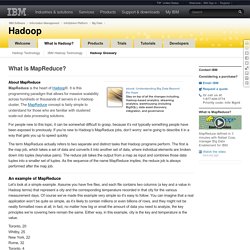
About MapReduce MapReduce is the heart of Hadoop®. It is this programming paradigm that allows for massive scalability across hundreds or thousands of servers in a Hadoop cluster. The MapReduce concept is fairly simple to understand for those who are familiar with clustered scale-out data processing solutions. MapReduce. Overview[edit] MapReduce is a framework for processing parallelizable problems across huge datasets using a large number of computers (nodes), collectively referred to as a cluster (if all nodes are on the same local network and use similar hardware) or a grid (if the nodes are shared across geographically and administratively distributed systems, and use more heterogenous hardware).
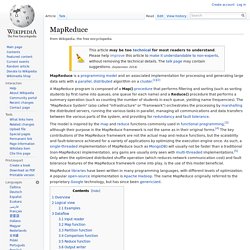
Processing can occur on data stored either in a filesystem (unstructured) or in a database (structured). MapReduce can take advantage of locality of data, processing it on or near the storage assets in order to reduce the distance over which it must be transmitted. "Map" step: Each worker node applies the "map()" function to the local data, and writes the output to a temporary storage. A master node orchestrates that for redundant copies of input data, only one is processed.
" MapReduce allows for distributed processing of the map and reduction operations. Logical view[edit] MongoDB. MongoDB (from "humongous") is a cross-platform document-oriented database.
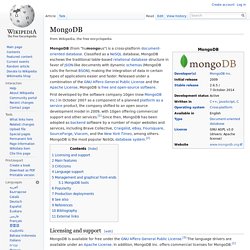
Classified as a NoSQL database, MongoDB eschews the traditional table-based relational database structure in favor of JSON-like documents with dynamic schemas (MongoDB calls the format BSON), making the integration of data in certain types of applications easier and faster. Released under a combination of the GNU Affero General Public License and the Apache License, MongoDB is free and open-source software. First developed by the software company 10gen (now MongoDB Inc.) in October 2007 as a component of a planned platform as a service product, the company shifted to an open source development model in 2009, with 10gen offering commercial support and other services.[1] Since then, MongoDB has been adopted as backend software by a number of major websites and services, including Brave Collective, Craigslist, eBay, Foursquare, SourceForge, Viacom, and the New York Times, among others.
Licensing and support[edit] Get Involved - MongoDB. Getting involved in the MongoDB community is a great way to build relationships with other talented engineers, increase awareness for the interesting work that you are doing, sharpen your skills, or give back.

Here are some of the ways that you can contribute to the MongoDB ecosystem. Discuss MongoDB through Community Forums Discuss, learn about, and get help with MongoDB through community-supported forums. We also offer office hours and paid support options. Oracle NoSQL Database Technical Overview. The Oracle NoSQL Database is a distributed key-value database.
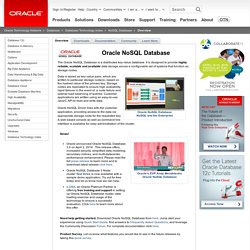
It is designed to provide highly reliable, scalable and available data storage across a configurable set of systems that function as storage nodes. Data is stored as key-value pairs, which are written to particular storage node(s), based on the hashed value of the primary key. Storage nodes are replicated to ensure high availability, rapid failover in the event of a node failure and optimal load balancing of queries. Customer applications are written using an easy-to-use Java/C API to read and write data.
Oracle NoSQL Driver links with the customer application, providing access to the data via appropriate storage node for the requested key. News! Need help getting started. Product Overview White Papers / Presentations. NoSQL. "Structured storage" redirects here.

For the Microsoft technology also known as structured storage, see COM Structured Storage. NoSQL Databases Explained. NoSQL encompasses a wide variety of different database technologies and were developed in response to a rise in the volume of data stored about users, objects and products, the frequency in which this data is accessed, and performance and processing needs.
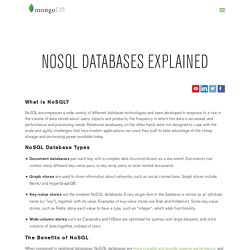
Relational databases, on the other hand, were not designed to cope with the scale and agility challenges that face modern applications, nor were they built to take advantage of the cheap storage and processing power available today. Document databases pair each key with a complex data structure known as a document. Documents can contain many different key-value pairs, or key-array pairs, or even nested documents.Graph stores are used to store information about networks, such as social connections. Graph stores include Neo4J and HyperGraphDB.Key-value stores are the simplest NoSQL databases. Every single item in the database is stored as an attribute name (or "key"), together with its value. Dynamic Schemas.